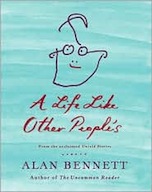 A Life Like Other People’s
A Life Like Other People’s
by Alan Bennett
Farrar, Straus and Giroux. 256 pages, $22.
ENGLISH PLAYWRIGHT Alan Bennett, who’s written over fifty scripts for stage and screen, has long been regarded as a national treasure in his home country, and he recently saw his career go mainstream here in the United States as well. The runaway success of his play The History Boys (2004), which won six Tony Awards and was adapted into a popular and critically acclaimed film in 2006, catapulted Bennett’s prolific career into the international spotlight. Despite his lengthy list of successes, the sudden attention that Bennett received outside the UK—especially for a work that’s more openly gay than anything else he had written—must have taken the writer, now aged 76, slightly by surprise. His most recent play, The Habit of Art (2009), is equally gay-themed, focusing on an imagined meeting between the poet W. H. Auden, the composer Benjamin Britten, and a “rent boy” in whom the two share an interest.
A Life Like Other People’s, Bennett’s latest memoir, was first published in his autobiographical essay collection Untold Stories (2005). This detailed and moving account of his early memories of his family, with closest attention given to his mother Lillian’s descent into depression and eventual dementia, works quite well as an individual volume and showcases Bennett’s craftsmanship as a prose writer. His narrative command feels relaxed yet masterful throughout the book, embracing a knack for dialogue, description, storytelling, and engaging character development all at once.
And what a cast of characters Bennett introduces here! From his shy, awkward parents to his quirky array of aunts and uncles, his characters are as much about their campy idiosyncrasies as about their personal tragedies and moments of truth. When the author’s mother is first hospitalized with what would later come to be diagnosed as clinical depression, his father notes, “Item no. 1 on the agenda, to get your Mam back to normal.” Bennett’s reaction to his father’s statement is also among his most valuable insights: “Except affliction was normal too, and this one seemingly more common than I thought.”
His mother’s hospitalization also brings to light a trauma in his family’s past: the suicide of his grandfather, who drowned himself in a canal, a secret kept from Bennett and his brother for forty years. Bennett begins to realize how severely the event affected his family, especially his parents, who feel they must maintain appearances at all costs. They avoid drawing attention to themselves in any way, even going so far as to get married at eight in the morning, when nobody would be likely to attend their wedding, so that Bennett’s father could report to his job at the local butcher shop on time, and his mother could return to her housekeeping duties.
Clearly, such strictures affected his parents socially as well: “Because if there was one consideration that determined my parents’ conduct and defined their position in the world it was not to be (or be thought) common. … Wanting to go unnoticed was what Mam’s depression was about.” As the book progresses, confronting the ghosts hidden in his familial history becomes crucial to Bennett’s ability to face his own.
Humor is never very far from the story’s action. In his reflections on his Aunt Kathleen, who worked as a uniformed “manageress” in an old-fashioned shoe store, Bennett muses: “It’s a sign of my age that shoe shops seem nowadays to be staffed by sluts, indifferent, unhelpful, and with none of that matronly dignity with which the selling of shoes and the buying of clothes were in those days conducted.” Then there’s Bennett’s recollection of a photograph of two Australian soldiers at a beach taken by his Aunt Myra, who was stationed in India during World War II: “It is ‘Ossie’ who draws the eye, better looking, with his arms folded and smiling, and with some reason, as he is weighed down, practically over-balanced, by what, even in the less than skimpy bathing trunks of the time, is a dick of enormous proportions, the bathing costume in effect just a hammock in which is lolling this colossal member.”
Revealingly, the word “gay” is never uttered anywhere in the book. Because Bennett has been so open about his personal life for years, it doesn’t really need to be. The closest he comes to mentioning it outright is during the book’s heartfelt finale, when he reconsiders the English village where he was raised: “I still live here with my partner, as the phrase is, who is fonder of the house and village even than I am. He is thirty years younger than me and what the village makes of this I do not know and now at last I do not care. That, at least, my parents’ lives have taught me.”
________________________________________________________
Jason Roush, author of After Hours, Breezeway
, and Crosstown
, teaches at Emerson College and New England Institute of Art.





